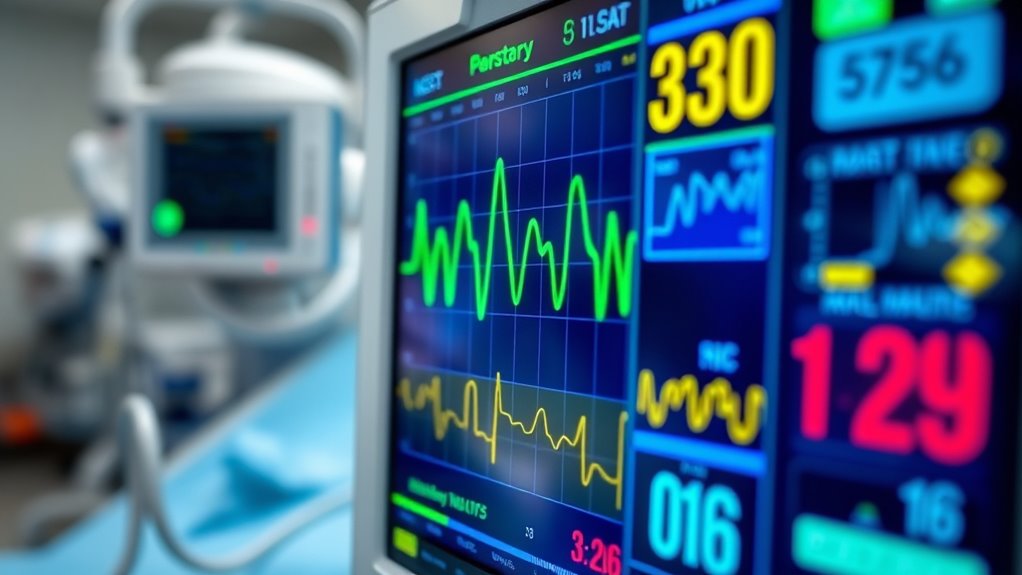To read a hospital monitor, focus on key essential signs displayed. First, check the heart rate in BPM; normal ranges are 60-100. Next, look at blood pressure, noting the systolic and diastolic numbers, ideally around 120/80 mmHg. Observe oxygen saturation levels, which should be between 95-100%. Finally, monitor the respiratory rate; normal is 12-20 breaths per minute. Understanding these metrics is crucial for evaluating health, and more in-depth information awaits you.
Understanding Heart Rate Readings
When you look at a hospital monitor, one of the most critical readings you’ll notice is the heart rate, often displayed as beats per minute (BPM). This essential sign reflects your heart rhythm, indicating how efficiently your heart pumps blood. A normal heart rate generally ranges from 60 to 100 BPM for adults. However, variations can signal underlying conditions. Arrhythmia detection is crucial in these scenarios, as irregular heartbeats can lead to serious health issues. By monitoring these readings, healthcare professionals can swiftly assess your cardiovascular health and make informed decisions about treatment. Understanding heart rate readings empowers you to engage in your health actively, ensuring you’re informed about your body’s signals and advocating for your well-being.
Interpreting Blood Pressure Measurements
Understanding blood pressure measurements is essential for evaluating cardiovascular health, especially since elevated or lowered readings can indicate various health issues. Blood pressure readings consist of two components: systolic pressure, the top number, and diastolic pressure, the bottom number. Systolic pressure measures the force of blood against artery walls during heartbeats, while diastolic pressure reflects the pressure when the heart is resting between beats. Normal readings are typically around 120/80 mmHg. Consistently high systolic readings can suggest hypertension, increasing the risk of heart disease. Conversely, low diastolic pressure might indicate insufficient blood flow to organs. By understanding these measurements, you can better advocate for your health and make informed decisions regarding lifestyle changes or medical consultations.
Decoding Oxygen Saturation Levels
Monitoring blood pressure is just one aspect of evaluating a patient’s overall health; oxygen saturation levels provide another critical insight into respiratory function. Using pulse oximetry, healthcare professionals measure the percentage of hemoglobin saturated with oxygen in the blood. A normal oxygen saturation level typically ranges from 95% to 100%. When levels drop below this range, it can indicate respiratory distress or other medical issues. You should pay attention to readings, especially if they fall below 90%, as this may necessitate immediate intervention. Understanding these numbers empowers you to engage in your health decisions, ensuring you’re informed and prepared to advocate for appropriate medical responses when oxygen saturation levels become concerning.
Monitoring Respiratory Rate
A key indicator of respiratory health is the respiratory rate, which measures the number of breaths a person takes per minute. Different monitor types, such as bedside monitors or portable devices, can track this essential sign effectively. When examining the readings, focus on the respiratory patterns; normal rates typically range from 12 to 20 breaths per minute for adults. Abnormal patterns, like rapid or shallow breathing, can indicate underlying health issues. It’s important to look for consistency in the data, as fluctuations may signal distress. Understanding these metrics empowers you to engage actively in your healthcare, ensuring that any concerning trends in respiratory rate are addressed promptly for ideal well-being.
Recognizing Other Key Vital Signs
While respiratory rate is crucial, recognizing other key important signs is equally critical for evaluating overall health. Pay attention to pulse rhythm; it reflects the heart’s efficiency and can indicate underlying issues. A regular pulse suggests a stable condition, while an irregular rhythm may signal potential complications. Additionally, observing important trends over time helps you understand changes in a patient’s health status. For instance, a sudden increase in heart rate could indicate stress or an infection. Staying vigilant about these signs allows you to provide better care and make informed decisions. Trust your instincts and combine your observations with the data from the monitor to guarantee a thorough assessment of the patient’s well-being.
Frequently Asked Questions
What Should I Do if the Monitor Beeps Unexpectedly?
If the monitor beeps unexpectedly, check for monitor alarms indicating issues. Assess the patient’s response and stability. If needed, notify the healthcare team promptly to guarantee the patient’s safety and address any potential concerns.
Can I Trust the Monitor’s Readings Completely?
You can’t trust the monitor’s readings completely. While it provides valuable data, monitor accuracy can vary due to sensor limitations. Always consider clinical judgment and consult healthcare professionals for a thorough understanding of your situation.
How Often Are the Readings Updated on the Monitor?
The monitor update frequency can vary, but crucial sign intervals are typically every few seconds to minutes. It’s important to understand these intervals for accurate assessment of a patient’s condition and to guarantee appropriate responses.
What Does a Flat Line Indicate on the Monitor?
When you see a flat line on the monitor, it often signals cardiac arrest, meaning the heart has stopped beating effectively. This alarming absence of rhythm demands immediate medical intervention to restore life.
Are Hospital Monitors Used for All Patients?
No, hospital monitors aren’t used for all patients. They’re typically reserved for those needing continuous patient monitoring, such as critical care patients. Various monitor types exist, tailored to different levels of care and monitoring needs.

